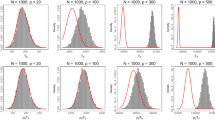Abstract
Any exploratory factor analysis model requires at least three indicators (observed variables) for each common factor to ensure model identifiability. If one would make exploratory factor analysis for a data set in which one of common factors would have only two indicators in its population, one would encounter difficulties such as improper solutions and nonconvergence of iterative process in calculating estimates.
In this paper, we first develop conditions for identifiability of the remaining factor loadings except for a factor loading vector which relates to a common factor with only two indicators. Two models for analyzing such data sets are then proposed with the help of confirmatory factor analysis and covariance structure analysis. The first model is an exploratory factor analysis model that permits correlation between unique factors; the second model is a kind of confirmatory factor model with equal factor loadings. Two real data sets are analyzed to illustrate usefulness of these models.
Similar content being viewed by others
References
Anderson, T.W. & Rubin, H. (1956). Statistical inference in factor analysis. Proceedings of the Third Berkeley Symposium on Mathematical Statistics and Probability, 5, 111–150. Berkeley: University of California Press.
Bechtoldt, H.P. (1961). An empirical study of the factor analysis stability hypothesis. Psychometri-ka, 26, 405–432.
Bentler, P.M. (1995). EQS structural equations program manual. Multivariate Software, Inc.: CA.
Browne, M.W. (1982). Covariance structures. In Topics in Applied Multivariate Analysis, (D.M. Hawkins, Ed.), pp. 72–141. Cambridge: Cambridge University Press.
Browne, M.W. (1984). Asymptotically distribution-free methods for the analysis of covariance structures. British Journal of Mathematical and Statistical Psychology, 37; 62–83.
Browne, M.W. (1996). Comments on the author’s talk at the Annual Meeting of Behaviormetric Society of Japan. Makuhari, Chiba.
Ihara, M. & Kano, Y. (1986). A new estimator of the uniqueness in factor analysis. Psychometrika, 51, 563–566.
Jennrich, R.I. & Robinson, S.M. (1969). A Newton-Raphson algorithm for maximum likelihood factor analysis. Psychometrika, 34, 111–123.
Jöreskog K.G. (1967). Some contributions to maximum likelihood factor analysis. Psychometrika, 32, 443–482.
Kano, Y. (1989). A new estimation procedure using G-inverse matrix in factor analysis. Math-ematica Japonica, 34, 43–52.
Kano, Y. (1990). Noniterative estimation and the choice of the number of factors in exploratory factor analysis. Psychometrika, 55, 277–291.
Kano, Y. & Ihara, M. (1994). Identification of inconsistent variates in factor analysis. Psychometrika, 59, 5–20.
Kaufman, A.S. (1975). Factor analysis of the WISC-R at 11 age levels between 6½ and 16½ years. Journal of Consulting and Clinical Psychology, 43, 135–147.
Kodama, S., Shinagawa, F. & Mogi, S. (1978). Nihonban WICS-R chinou kensahou (Japanese version of the WISC-R), Tokyo: Nihon Bunka Kagakusha (In Japanese).
Okamoto, M. (1987). Inshibunseki no saikin no hatten (Recent developments in factor analysis). In Shakaikagaku no keiryoubunseki (Measurement Analysis in Social Sciences), (S. Suzuki and K. Takeuchi, Eds.), pp. 7–26. Tokyo: University of Tokyo Press (In Japanese).
Okamoto, M. & Ihara, M. (1984). Partial Gauss-Newton algorithm for least-squares and maximum likelihood methods in factor analysis. Journal of the Japan Statistical Society, 14, 137–144.
Rindskof, D. (1984). Structural equation models: Empirical identification, Heywood cases, and related problems. Sociological Research and Methods, 13, 109–119.
Sato, M. (1992). A study of an identification problem and substitute use of principal component analysis in factor analysis. Hiroshima Mathematical Journal 22, 479–524.
Thurstone, L.L. & Thurstone, T.G. (1941). Factorial studies of intelligence. Psychometric Monograph No. 2. Chicago: University of Chicago Press.
Toyoda, H. (1992). SAS niyoru kyoubunsan kouzou bunseki (Covariance structure analysis with SAS). Tokyo: University of Tokyo Press (In Japanese).
Tumura, Y. & Sato, M. (1981). On the convergence of iterative procedures in factor analysis. TRU Mathematics, 17, 159–168.
Ueno, K. (1982). WISC-R no hyoujunka dehta no inshibunseki (Factor analysis of standaridized WISC-R data). Shinri Sokutei Jahnaru Journal of Psychometry), 18, 19–21 (In Japanese).
van Driel, O.P. (1978). On various causes of improper solutions in maximum likelihood factor analysis. Psychometrika, 43, 225–243.
Watanabe, H. (1992). Tahenryou kaiseki nyuumon: Jireihen (Introduction to multivariate analysis: Applications). Tokyo: Fukumura Shuppan (In Japanese).
Watanabe, H. (1993). Shinri kensahou nyuumon (Introduction to methods of psychological measurements). Tokyo: Fukumura Shuppan (In Japanese).
Author information
Authors and Affiliations
About this article
Cite this article
Kano, Y. Exploratory Factor Analysis with a Common Factor with Two Indicators. Behaviormetrika 24, 129–145 (1997). https://doi.org/10.2333/bhmk.24.129
Received:
Revised:
Published:
Issue Date:
DOI: https://doi.org/10.2333/bhmk.24.129




